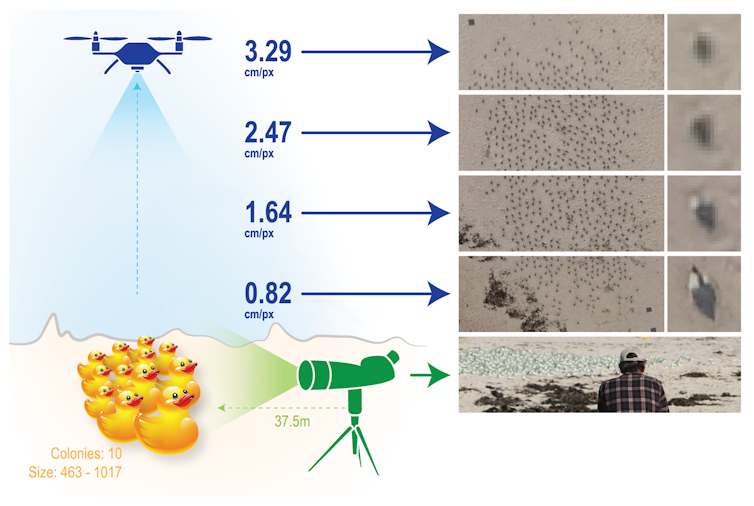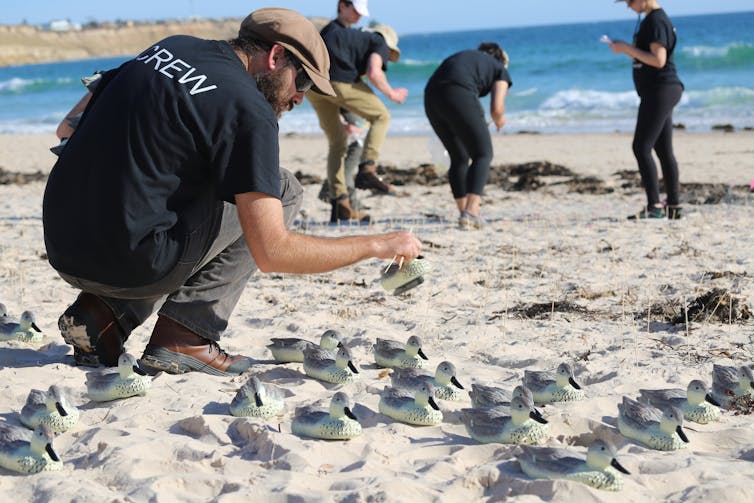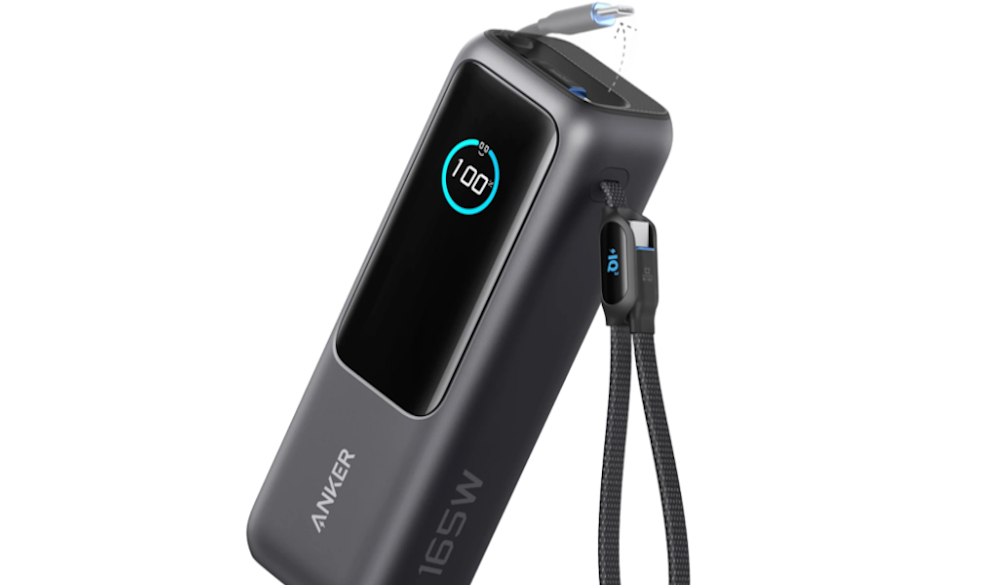'Epic Duck Challenge' shows drones can outdo people at surveying wildlife
- Written by Jarrod Hodgson, PhD Candidate, University of Adelaide
Ecologists are increasingly using drones to gather data. Scientists have used remotely piloted aircraft to estimate the health of fragile polar mosses, to measure and predict the mass of leopard seals, and even to collect whale snot. Drones have also been labelled as game-changers for wildlife population monitoring.
But once the take-off dust settles, how do we know if drones produce accurate data? Perhaps even more importantly, how do the data compare to those gathered using a traditional ground-based approach?
To answer these questions we created the #EpicDuckChallenge, which involved deploying thousands of plastic replica ducks on an Adelaide beach, and then testing various methods of tallying them up.
As we report today in the journal Methods in Ecology and Evolution, drones do indeed generate accurate wildlife population data – even more accurate, in fact, than those collected the old-fashioned way.
 Jarrod Hodgson standing in one of the replica colonies of seabirds constructed for the #EpicDuckChallenge.
S. Andriolo
Jarrod Hodgson standing in one of the replica colonies of seabirds constructed for the #EpicDuckChallenge.
S. Andriolo
Assessing the accuracy of wildlife count data is hard. We can’t be sure of the true number of animals present in a group of wild animals. So, to overcome this uncertainty, we created life-sized, replica seabird colonies, each with a known number of individuals.
From the optimum vantage and in ideal weather conditions, experienced wildlife spotters independently counted the colonies from the ground using binoculars and telescopes. At the same time, a drone captured photographs of each colony from a range of heights. Citizen scientists then used these images to tally the number of animals they could see.
Counts of birds in drone-derived imagery were better than those made by wildlife observers on the ground. The drone approach was more precise and more accurate – it produced counts that were consistently closer to the true number of individuals.
 Comparing the vantages: drone-derived photographs and the ground counter’s view.
J. Hodgson
Comparing the vantages: drone-derived photographs and the ground counter’s view.
J. Hodgson
The difference between the results was not trivial. Drone-derived data were between 43% and 96% more accurate than ground counts. The variation was due to how many pixels represented each bird, which in turn is related to the height that the drone was flown and the resolution of the camera.
This wasn’t a surprise. The experienced ground counters did well, but the drone’s vantage point was superior. Observing photos taken from above meant the citizen scientists did not have to contend with obscured birds that often occur during ground counts. The imagery also benefited the citizen scientists as they could digitally review their counts as many times as they needed. This reduced the likelihood of both missing an individual and counting an individual more than once.
 The scientists were assisted by many volunteers, without whom the #EpicDuckChallenge would not have been possible.
J. Hodgson
The scientists were assisted by many volunteers, without whom the #EpicDuckChallenge would not have been possible.
J. Hodgson
However, even though it proved to be more accurate, making manual digital counts is still tedious and time-consuming. To address this, we developed a computer algorithm in the hope that it could further improve efficiency without diminishing data quality. And it did.
We delineated a proportion of birds in each colony to train the algorithm to recognise how the animal of interest appeared in the imagery. We found that using 10% training data was sufficient to produce a colony count that was comparable to that of a human reviewing the entire scene.
This computerisation can reduce the time needed to process data, providing the opportunity to cut the costs and resources needed to survey wildlife populations. When combined with the efficiencies drones provide for surveying sites that are hard to access on foot, these savings may be considerable.
Our results have important implications for a range of species. We think they are especially relevant to aggregating birds, including seabirds like albatrosses, surface nesting penguins and frigatebirds, as well as colonial nesting waterbirds like pelicans.
Other types of animals that are easily seen from above, including hauled-out seals and dugongs, are highly suited to drone monitoring. The nests or tracks of animals, such as orangutans and turtles, can also be used to infer presence.
Additional experiments will be useful to assess the ability of drones to survey animals that prefer to stay hidden and those within complex habitats. Such assessments are of interest to us, and researchers around the globe, with current investigations focused on wildlife such as arboreal mammals and cetaceans.
We are still learning about how wildlife react to the presence of drones, and more research is required to quantify these responses in a range of species and environments. The results will help to refine and improve drone monitoring protocols so that drones have minimal impact on wildlife. This is particularly important for species that are prone to disturbance, and where close proximity is not possible or desirable.
Read more: How drones can help fight the war on shark attacks
The world is rapidly changing, with many negative outcomes for wildlife. Technology like drones can help scientists and managers gather data fast enough to enable timely assessment of the implications of these changes.
When monitoring wildlife, increasing the accuracy and precision of animal surveys gives us more confidence in our population estimates. This provides a stronger evidence base on which to make management decisions or policy changes. For species and ecosystems threatened with extinction or irreparable damage, such speedy action could be a literal lifeline.
Authors: Jarrod Hodgson, PhD Candidate, University of Adelaide



















